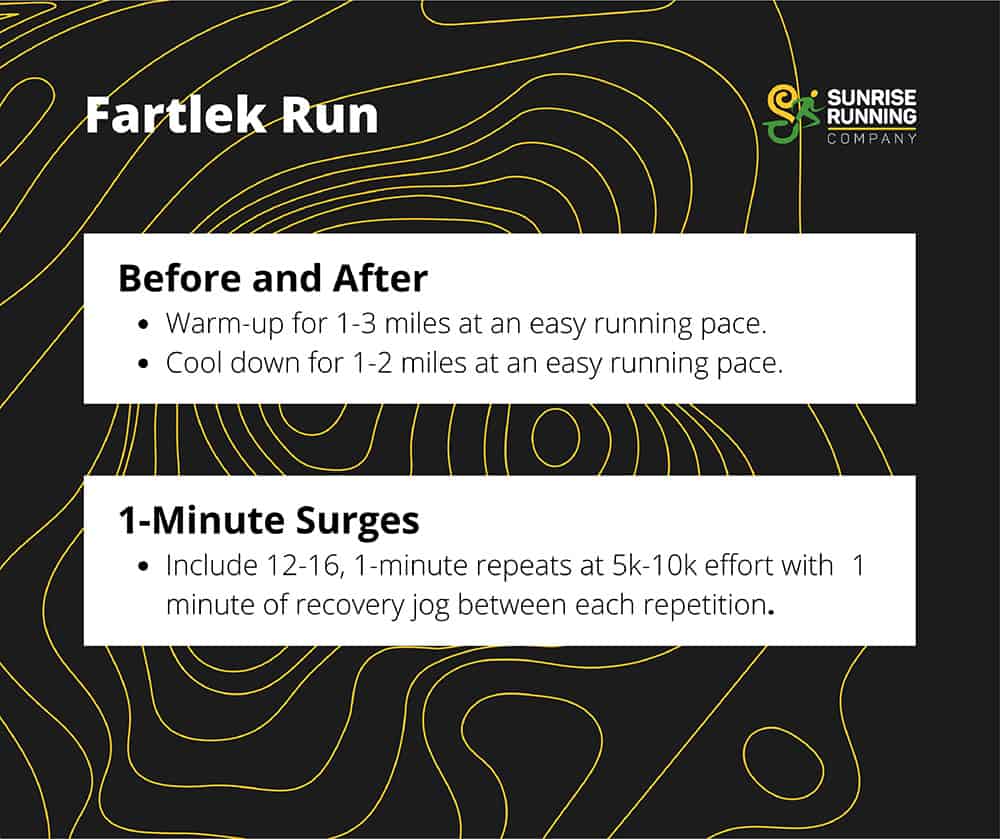Is the key to unlocking your speed including Fartlek Runs?
Fartlek runs (meaning ‘speed play’ in Swedish) have a 90-plus year history in performance training. The style of training, which essentially consists of unstructured speed work, was pioneered in the 1930s by the Swedish decathlete and coach Gösta Holmér. Holmér developed the training style while coaching the Swedish cross-country team, which was struggling competitively.
The idea of Fartlek runs is that they can be done anywhere and that their pacing is entirely at the runner’s discretion. However, the method reflects a more natural style of running in which runners can choose to speed up or slow down at will, ideally while maintaining a moderate baseline pace. Unlike interval training, there are no rest periods following speed work during a Fartlek run.
Benefits of Fartlek Runs
So why should you incorporate Fartlek runs into your training? From a physiological perspective, Fartlek training is incredibly effective at increasing your lactate threshold.
The lactate threshold is when your body is unable to remove lactate faster than it is being produced during exercise, which ultimately leads to exhaustion (sometimes described as the point where you cross from moderate intensity to high intensity). The higher your lactate threshold, the better your sub-maximal performance. Because Fartlek training calls for working at alternating moderate and vigorous intensities, your body has little time to recover. Your body must adapt to the higher workload by clearing lactate faster. Therefore, researchers have found that Fartlek training is an effective method of improving both speed and endurance.
Aside from the physiological benefits, Fartlek runs can be a good starting point for incorporating more speed work into your training. For example, speed intervals in Fartlek runs can be time or distance-based, allowing you to ease into a training style that suits you.
In the early weeks of your training, Fartlek runs can be instrumental in helping you integrate speed work on your terms and eventually work towards a race pace. They also allow you to respond to your body and learn how to push yourself without the rigor of a specific plan. This can be invaluable training for a race when you may need to adapt to novel conditions.
Four Tips to Make Your Fartlek Runs Successful
1. Try to keep running throughout the session.
If you feel that you need to stop following a speed interval, you are likely running too fast. Remember that maintaining a moderate recovery pace is the most valuable part of Fartlek training. Learn to adapt your speed and recovery pace accordingly to maximize the benefits.
2. Focus on perceived effort and not your watch.
Release the urge to check your watch or heart rate monitor during your speed sessions and focus instead on your perceived effort. Fartlek runs are intended to be responsive to your body. In other words, technology-based measurements won’t serve you here.
3. Add variety to the interval length.
Consider using your environment to help you with fartlek training. Use place-based milestones such as the two blocks further or to the next street corner to set the length of your speed intervals.
4. Allow time for recovery.
Don’t forget to give yourself time to rest after a Fartlek workout! Like any speed workout, Fartlek runs can be intense, and you’ll want to give your body time to recover to maximize the benefits of training.
Examples of Workouts
Again, there is any number of possibilities for structuring a Fartlek run. How you choose to perform this workout will largely depend on your current ability level, overall goals, where it falls within your current training cycle/routine. Here are a few examples, of how to structure your next Fartlek run:
30-Second Surges
- Warm-up for 1 to 3 miles at an easy running pace, aerobic effort.
- Include 10 to 20, 30-second repeats at 5k-10k effort (lactate threshold pace) with 1-minute of recovery jog between each repetition.
- Cool down for 1 to 2 miles at an easy running pace.
1-Minute Surges
- Warm-up for 1 to 3 miles at an easy running pace, aerobic effort.
- Include 12-16, 1-minute repeats at 5k-10k effort (lactate threshold pace) with 1-minute of recovery jog between each repetition.
- Cool down for 1 to 2 miles at an easy running pace.
Fartlek Ladder
- Warm-up for 1 to 3 miles at an easy running pace, aerobic effort.
- Interval Ladder
- Run 30-seconds at 5k-10k effort (lactate threshold pace), followed by 30-seconds of recovery jog.
- Run 60-seconds at 5k-10k effort, followed by 60-seconds of recovery jog.
- Run 90-seconds at 5k-10k effort, followed by 90-seconds of recovery jog.
- Run 60-seconds at 5k-10k effort, followed by 60-seconds of recovery jog.
- Run 30-seconds at 5k-10k effort (lactate threshold pace), followed by 30-seconds of recovery jog.
- Repeat the 30-60-90-60-30 second ladder 1 to 3 times based on your ability level and goals.
- Cool down for 1 to 2 miles at an easy running pace.
A Training Plan that Works for You.
Our collection of running plans will help you train year-round. From 5k to a 100-mile ultramarathon, we have a training plan built for your experience level and goals. Every plan is delivered via Final Surge, allowing you to sync workouts across devices, receive daily reminders of workouts and activities, and analyze workout and target zone details. Get started today with a training plan built for you, view our running plans here.











